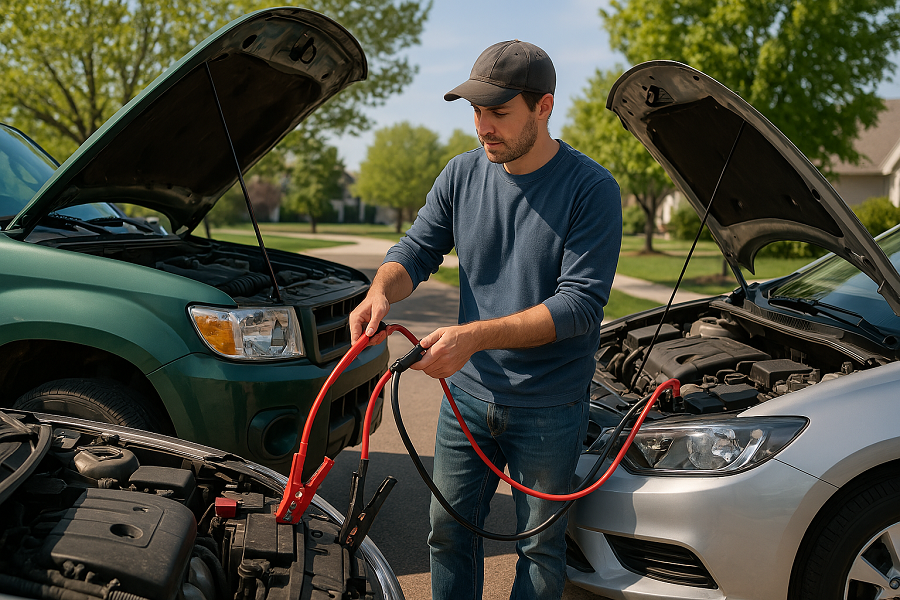It’s a frustrating moment—you’re ready to go, but your car won’t start. In most cases, the culprit is a dead car battery. Knowing how to jump start a car is a simple yet essential skill that can save you time, money, and stress. Whether you’re stuck at home or in a parking lot, this guide shows you how to jump a car safely, using jumper cables or a portable jump starter, and what to do if that doesn’t work.

Signs Your Car Battery Is Dead
Before you jump start the car, check for signs of a dead battery:
- Dim headlights or dashboard lights
- Clicking noise when turning the key
- Electronics not working (radio, power windows)
These symptoms indicate your car battery doesn’t have enough power. Recognizing these signs helps you act quickly and decide whether you need a jump or professional help with your starter or alternator.
Safety Precautions Before You Begin
Safety is crucial when learning how to jump a car battery. Follow these tips: AAA Safety Tips
- Turn off both vehicles.
- Keep metal clamps from touching.
- Avoid jumping a leaking or swollen battery.
- Wear gloves and eye protection.
- Be cautious of reverse polarity—it can damage your car.
These simple jump start safety tips help prevent injury and protect your vehicle’s electrical system.
What You’ll Need to Jump Start a Car
Make sure you have the right tools before you start:
- Jumper cables (preferably 4-gauge)
- A working car or portable jump starter
- Safety gear: gloves, flashlight, and glasses
These items are essential for anyone learning how to jump a car battery by yourself. Having them ready ensures you’re prepared during emergencies.
How to Jump Start a Car with Another Car
Follow these steps to jump start a car using cables: how jumper cables work
- Park both cars close, engines off.
- Attach red clamp to dead battery’s positive terminal.
- Attach other red clamp to good battery’s positive terminal.
- Connect black clamp to good battery’s negative terminal.
- Connect other black clamp to an unpainted metal surface on the dead car.
- Start the working car, then start the dead one.
- Remove cables in reverse order.
This is the standard method for how to jump a car with cables.
How to Jump Start a Car with a Portable Jump Starter
If no second car is available, use a portable jump starter:
- Turn off the device before connecting.
- Attach red clamp to the positive terminal.
- Attach black clamp to a metal ground.
- Turn on the jump starter.
- Start the car.
- Turn off the jump starter and remove cables.
This method allows you to jump start a car without another car, ideal for solo drivers.
After a Successful Jump Start
After starting the car, keep the engine running for 15–30 minutes to recharge the battery. Drive rather than idle to charge it faster. If the car dies again quickly, the issue could be a weak battery or a bad alternator. Consider replacing the battery or getting your charging system tested.
Common Mistakes to Avoid
Avoid these common jump start mistakes:
- Reversing the cable connections (reverse polarity)
- Letting clamps touch during connection
- Jumping a damaged or frozen battery
- Using frayed or cheap jumper cables
Doing it wrong can damage electronics or cause injury. Always follow proper jump starting steps.
Car Still Won’t Start? Troubleshooting Tips
If your car won’t start even after a jump:
- Inspect for corroded terminals
- Test battery with a multimeter (below 12V = weak)
- Check for a faulty starter or bad alternator
- Look at fuse box or listen for relay clicks
These steps help you rule out issues beyond the battery. If still unresolved, call a mechanic.
How to Maintain Your Car Battery
To prevent future issues:
- Turn off all electronics when exiting the car
- Clean battery terminals regularly
- Drive often to keep the battery charged
- Check battery condition in cold weather
- Replace every 3–5 years
Carrying a portable jump starter also ensures you’re ready for emergencies. These simple habits keep your car battery healthy.
Can You Jump Start Any Type of Car
You can jump start most vehicles, but not all:
- Hybrid and electric cars require special procedures
- Manual cars can be push-started
- Automatic cars require a jump pack or cables
Always consult your owner’s manual before jumping unfamiliar vehicles. Use only approved devices for jump starting hybrid or electric cars.
Jump Starting in Bad Weather
Yes, you can jump start a car in the rain or snow, but be careful:
- Stay dry; avoid standing water
- Use gloves and rubber-soled shoes
- Ensure clamps and battery are dry
Cold weather slows battery performance. Use a jump starter designed for cold weather for better results.

Best Tools for Jump Starting
Equip your car with reliable tools:
- Heavy-duty jumper cables (10+ feet, 4-gauge)
- Jump starter pack (1000+ peak amps)
- Smart chargers that test battery health
- Flashlight, gloves, and safety kit
These are the best tools to jump start a car and prepare for emergencies. Keep them in your trunk for peace of mind.
FAQs
Can I jump start a car with a motorcycle? Yes, if voltage matches.
How long should jumper cables stay connected? About 1–2 minutes after starting.
Can jump starting damage my car? Yes, if done improperly.
Can I jump start in the rain? Yes, with precautions.
Why won’t my car start after a jump? Possibly a bad battery, starter, or alternator.
Final Thoughts
Knowing how to jump start a car is a valuable life skill. With the right tools and knowledge, it’s easy to handle a dead car battery on your own. Avoid mistakes, follow safety steps, and maintain your battery to prevent future problems.
Stay prepared—share this guide, save it, and keep a jump starter in your trunk.
Leave a Reply